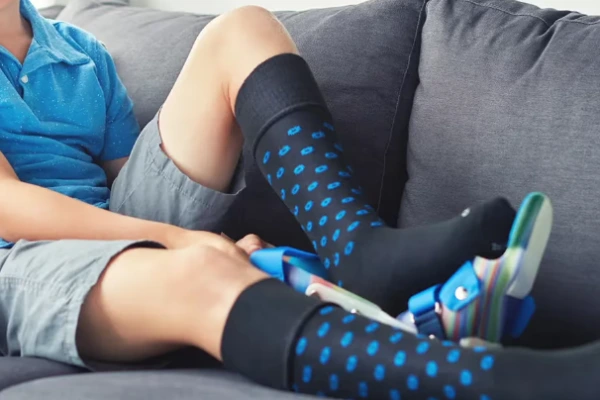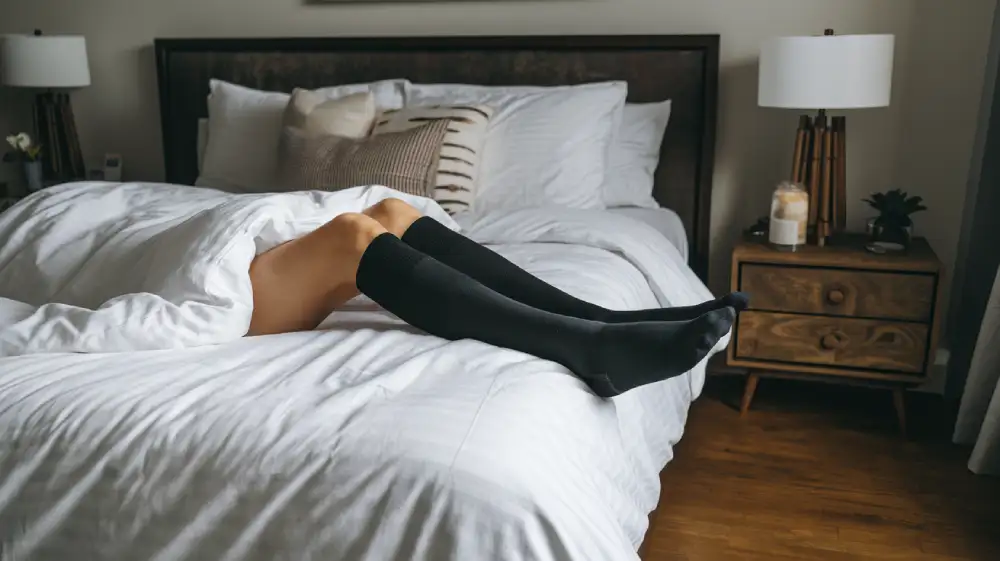Introduction: The Nighttime Compression Question
The question of whether compression socks should be worn during sleep represents one of the most common yet complex inquiries in compression therapy. While these specialized garments have established benefits during daytime activities, their role during sleep remains surrounded by conflicting advice and misconceptions. This comprehensive guide explores the nuanced considerations of nighttime compression, examining the potential benefits, risks, and appropriate applications of wearing compression socks to bed. By understanding the physiological effects of overnight compression, the specific conditions that might benefit, and important safety considerations, readers can make informed decisions about incorporating this practice into their health routines. Rather than providing oversimplified yes-or-no answers, this guide acknowledges that nighttime compression needs vary significantly based on individual circumstances, medical conditions, and specific therapeutic goals—requiring personalized approaches rather than universal recommendations.

The Physiology of Nighttime Compression
How Sleep Position Affects Circulation
When we lie down to sleep, our circulatory dynamics shift. During the day, gravity pulls blood toward the legs, making compression socks useful for promoting upward flow. At night, the legs are nearly level with the heart, reducing gravitational pressure and naturally improving circulation. This change lessens the need for strong compression during sleep and explains why continuous wear may provide little benefit—or even discomfort—for some individuals.
Circulatory Behavior During Sleep
Sleep brings its own circulatory rhythms. Blood pressure and heart rate drop, and peripheral vessels widen during deep sleep. These changes can conflict with the tightening effect of compression garments. Additionally, because muscle movement stops during sleep, the body loses the calf-muscle pump action that aids circulation during the day. For some, this may justify light compression at night, especially if swelling persists after rest. For others, unnecessary pressure can disturb sleep or worsen symptoms.
Why Individualized Advice Matters
Not everyone responds the same to nighttime compression. Those with chronic venous insufficiency may benefit, while individuals with arterial disease or sensitive skin may experience harm. Personalized assessment is key to determining whether nighttime compression is helpful or risky. Following general advice without considering your health profile can lead to unintended outcomes.
Potential Benefits of Overnight Compression
Medical Conditions That May Benefit
Overnight compression may benefit individuals with specific medical conditions requiring consistent symptom control. For example, patients with severe venous insufficiency often report nighttime leg cramps and restlessness, which can be eased by wearing compression garments during sleep. People with post-thrombotic syndrome or chronic leg swelling may experience symptom relief and improved fluid control through continuous support. Lymphedema patients, especially in early treatment stages, sometimes need round-the-clock compression to prevent fluid buildup during rest. Surgical recovery protocols may also call for overnight use to reduce post-op complications and maintain healing progress. In all cases, overnight compression should be guided by healthcare professionals and tailored to individual needs.
Recovery Support for Athletes
Some athletes use overnight compression to speed up recovery following intense training or competition. Eccentric exercises and high-impact sports generate muscle damage and inflammation that continue even during sleep. Compression garments may help by managing swelling, improving circulation, and reducing soreness after workouts. These benefits are especially useful for elite athletes with tight schedules or consecutive events where fast recovery is critical. However, comfort is key—tight or poorly fitted garments can disturb sleep, which is equally important for recovery. Athletes interested in overnight use should test products carefully and balance pressure level with sleep quality for best results.
Potential Risks and Contraindications
When Nighttime Compression Should Be Avoided
Despite potential benefits for some conditions, several circumstances present clear contraindications for overnight compression use. Patients with peripheral arterial disease or significant arterial insufficiency should generally avoid nighttime compression due to risks of further restricting already compromised blood flow during periods of reduced movement and monitoring. Those with certain skin conditions, particularly those affecting skin integrity or sensation, may face increased risks of tissue damage from prolonged compression without regular position changes and skin checks that naturally occur during waking hours. Individuals with cardiac conditions causing fluid balance challenges require careful assessment, as nighttime compression can potentially affect cardiac preload and fluid distribution patterns in ways that might impact heart function during sleep. Those with severe neuropathy or sensation loss face particular risks from undetected pressure points that might develop during extended immobile periods in compression garments. These contraindications emphasize the importance of professional medical evaluation before initiating overnight compression, particularly for individuals with complex health histories or multiple chronic conditions that might create competing risk-benefit considerations requiring careful clinical judgment rather than generalized recommendations.
Skin Health and Circulation Concerns
Extended continuous compression during sleep periods creates specific concerns for skin health and microcirculation that require careful consideration. The combination of prolonged pressure, potential moisture accumulation, and reduced position changes during sleep can create conditions conducive to skin irritation, pressure points, or even tissue damage in vulnerable individuals. Without the natural movement that occurs during waking hours, compression garments may create consistent pressure in specific areas, potentially compromising microcirculation to these tissues over the 6-8 hour sleep period. Those with fragile skin, reduced sensation, or compromised healing capacity face particular risks from these extended compression periods without the regular assessment and adjustment that naturally occurs during daytime wear. Moisture trapped between skin and compression fabric during extended wear periods can lead to maceration that further increases skin vulnerability, particularly in warm sleeping environments or for individuals who experience night sweats. These skin health considerations explain why many healthcare providers recommend removing compression garments during sleep periods except in specific circumstances where the medical benefits clearly outweigh these potential risks under appropriate monitoring protocols.
Expert Recommendations and Guidelines
Medical Perspectives on Overnight Compression
Healthcare provider recommendations regarding overnight compression vary based on specialty, patient population, and individual practitioner experience, though several consistent themes emerge across professional guidance. Vascular specialists typically emphasize individualized assessment rather than blanket recommendations, considering each patient’s specific circulatory status, symptoms, and risk factors when advising about nighttime compression. Wound care specialists often support overnight compression for patients with venous ulcers or significant edema affecting wound healing, while emphasizing proper fit and regular skin monitoring. Lymphedema therapists frequently incorporate nighttime compression into treatment protocols, particularly during intensive therapy phases, though often with specialized garments designed specifically for overnight use rather than standard daytime compression socks. Sleep medicine specialists contribute important perspectives about potential impacts on sleep quality and architecture, recognizing that discomfort from compression garments might disrupt sleep cycles essential for overall health despite potential circulatory benefits. These nuanced professional perspectives highlight why patients should seek personalized medical advice rather than following general guidelines, particularly when considering compression use for specific medical conditions rather than general wellness purposes.
Compression Levels for Sleep Applications
When overnight compression is medically indicated, the appropriate compression level typically differs from daytime recommendations, requiring careful consideration of both therapeutic needs and safety factors during the extended, unmonitored sleep period. While daytime compression often ranges from 15-30+ mmHg depending on the condition being addressed, nighttime compression generally trends toward the lower end of this spectrum to balance therapeutic benefits with comfort and safety during periods of reduced movement and monitoring. Mild compression (8-15 mmHg) often provides sufficient benefit for preventive purposes or minor symptoms while minimizing risks during sleep. Moderate compression (15-20 mmHg) may be appropriate for specific conditions under medical guidance, while higher levels typically require explicit medical direction with clear monitoring protocols. Some medical conditions benefit from specialized nighttime garments that provide consistent mild compression throughout rather than the graduated pressure profile typical of daytime options, creating more uniform support during recumbent positions when gravitational challenges diminish. This conservative approach to nighttime compression levels reflects the reduced need for gravitational assistance during recumbent positions and the increased importance of comfort for sleep quality maintenance while still providing therapeutic benefits for specific conditions requiring continuous compression support.
Practical Implementation Strategies
Alternatives to Full-Night Compression

For those seeking circulatory benefits without the potential drawbacks of all-night compression wear, several alternative approaches offer middle-ground solutions worth considering. Some practitioners recommend wearing compression socks for 1-2 hours before bedtime while elevating the legs, then removing them for sleep—providing evening symptom management while avoiding overnight wear concerns. Others suggest applying compression first thing in the morning before rising from bed, capturing the benefit of application before gravitational challenges begin without requiring overnight wear. Specialized nighttime garments designed specifically for sleep, with lower compression levels and more comfortable materials, offer another alternative to standard daytime compression socks for those requiring some overnight support. Compression wraps that can be adjusted throughout the night provide options for those who experience discomfort with continuous unchanging pressure. These flexible approaches acknowledge that compression therapy need not be an all-or-nothing proposition, with various implementation strategies potentially providing benefits while minimizing the drawbacks associated with sleeping in standard compression socks designed primarily for daytime wear and upright activities rather than recumbent rest periods.
Monitoring for Complications
For individuals using overnight compression under medical guidance, vigilant monitoring for potential complications becomes essential for safe implementation. Users should establish baseline awareness of normal skin appearance and sensation to recognize concerning changes quickly. Morning skin inspection should focus on identifying persistent indentations, unusual discoloration (particularly whiteness or purple/blue tones), increased pain or numbness, and any signs of skin breakdown that might indicate excessive pressure or compromised circulation during the sleep period. Symptoms like increased pain during the night, new numbness or tingling, or color changes visible through the garment warrant immediate removal and assessment. Some providers recommend periodic overnight breaks from compression to evaluate how symptoms respond to intermittent rather than continuous use. This monitoring approach acknowledges that the risk-benefit balance of overnight compression requires ongoing assessment rather than one-time determination, with adjustments based on observed responses and changing health conditions. Individuals with reduced sensation face particular monitoring challenges and may require assistance with regular skin checks to ensure safety during overnight compression therapy.
Specialized Products for Nighttime Use
Compression Garments Designed for Sleep
Recognizing the unique requirements of nighttime compression, manufacturers have developed specialized products designed specifically for sleep applications rather than simply repurposing daytime compression socks for overnight use. These purpose-designed sleep compression garments typically feature softer, more breathable fabrics that enhance comfort during extended wear periods while maintaining therapeutic benefits. Many incorporate non-constrictive top bands that prevent the uncomfortable constriction that standard compression socks might create during natural sleep movements and position changes. Some designs feature variable compression zones with reduced pressure in areas vulnerable to nerve compression during recumbent positions, particularly around the ankle and foot where standard daytime compression typically applies greatest pressure. Moisture-wicking properties become particularly important for overnight designs to prevent skin maceration during extended wear periods, especially for those who experience night sweats or use warming bedding. These specialized design elements address the specific challenges of nighttime compression, potentially providing therapeutic benefits with reduced risk and discomfort compared to wearing standard daytime compression socks to bed—acknowledging the different physiological needs and comfort requirements of compression during sleep versus active daytime wear.
Adjustable Compression Systems
For individuals requiring overnight compression with greater adaptability than standard garments provide, adjustable compression systems offer valuable alternatives worth considering. Velcro-closure wraps allow pressure customization throughout the night, enabling users to loosen compression if discomfort develops or tighten support in response to symptom changes without completely removing the compression system. Some advanced options incorporate separate adjustable zones for ankle, calf, and knee areas, allowing targeted pressure application based on individual needs and comfort requirements. These adjustable systems prove particularly valuable for conditions with fluctuating symptoms or for users who experience comfort changes throughout the night that might otherwise disrupt sleep with standard non-adjustable compression garments. The ability to make minor pressure adjustments without fully removing and reapplying compression helps maintain therapeutic benefits while addressing the comfort concerns that often limit compliance with overnight compression recommendations. While typically more expensive than standard compression socks, these adjustable systems may provide better overall value for those requiring nighttime compression by improving comfort, enhancing compliance, and potentially extending product lifespan through adaptability to changing needs and conditions over time.
Alternative Approaches to Nighttime Leg Health
Elevation Strategies and Techniques
Raising the legs above heart level during sleep can improve venous return and reduce swelling—offering a gentle, non-compressive option for managing nighttime leg discomfort. Elevation of 6–12 inches using foam wedges or adjustable beds is more effective than stacked pillows, which often slip or create uneven angles. The ideal elevation angle is 15–20 degrees, balancing comfort with circulatory benefits. Some leg-elevation pillows are contoured to maintain alignment during sleep, even with movement. For people unable to tolerate overnight compression or those with mild symptoms, elevation is a low-risk alternative. In more serious cases, it can be used alongside doctor-recommended compression to enhance results without overloading tissues.
Evening Routines to Minimize Overnight Swelling
Simple routines before bed can reduce fluid buildup overnight. A 15–20 minute session of leg elevation, light self-massage with upward strokes, or ankle pumping exercises can all support healthy circulation. Evening walks also activate calf muscles and stimulate venous return, especially for those with venous insufficiency. Avoiding salty foods late in the day and maintaining steady hydration throughout the day (rather than drinking large volumes before bed) also reduces nighttime fluid retention. These habits are especially helpful for individuals who can’t wear compression socks at night or who want to reduce their dependence on them. When used consistently, these alternatives can maintain leg comfort, reduce swelling, and support circulation—offering safe, effective relief that doesn’t interfere with sleep quality or comfort.
Conclusion: Making an Informed Decision About Nighttime Compression
The question of whether compression socks should be worn to bed does not have a universal answer. Instead, it requires thoughtful consideration of individual health conditions, symptoms, risk factors, and daily comfort. For some—especially those managing severe venous insufficiency, lymphedema, or post-thrombotic syndrome—overnight compression may provide relief when used under medical guidance. For others, non-compressive alternatives may offer safer nighttime support.

Understanding the science, risks, and recovery benefits outlined in this guide equips you to make better decisions in partnership with healthcare professionals. A tailored approach will always yield better outcomes than one-size-fits-all solutions—especially when both health and sleep are at stake.
If your brand or retail business is looking to offer medical or sleep-safe compression socks, we welcome you to explore our website. Max Hosiery specializes in custom sock manufacturing, including professional-grade compression styles tailored to your specific needs. Whether you require private-label development or niche product support, our team is ready to help.
FAQ Section
Is it dangerous to wear compression socks to bed every night?
It can be risky without medical advice. People with arterial issues or skin problems should avoid it. Overnight use should only happen under doctor supervision.
What compression strength is best for overnight wear if medically recommended?
8-15 mmHg is safest for sleep. Higher levels require medical oversight. Never self-prescribe strong compression for overnight use.
Can wearing compression socks at night worsen circulation for some people?
Yes, especially with arterial disease. Compression may reduce blood flow further. Always consult a doctor first.
How do I know if overnight compression is helping or hurting me?
Watch for reduced swelling and better comfort. Pain, numbness, or skin issues mean it may be harming you. Consult a professional if unsure.
Are there special compression socks designed specifically for sleep?
Yes. These use softer fabrics, light pressure, and seamless construction. They’re safer and more comfortable than daytime socks for sleeping.
